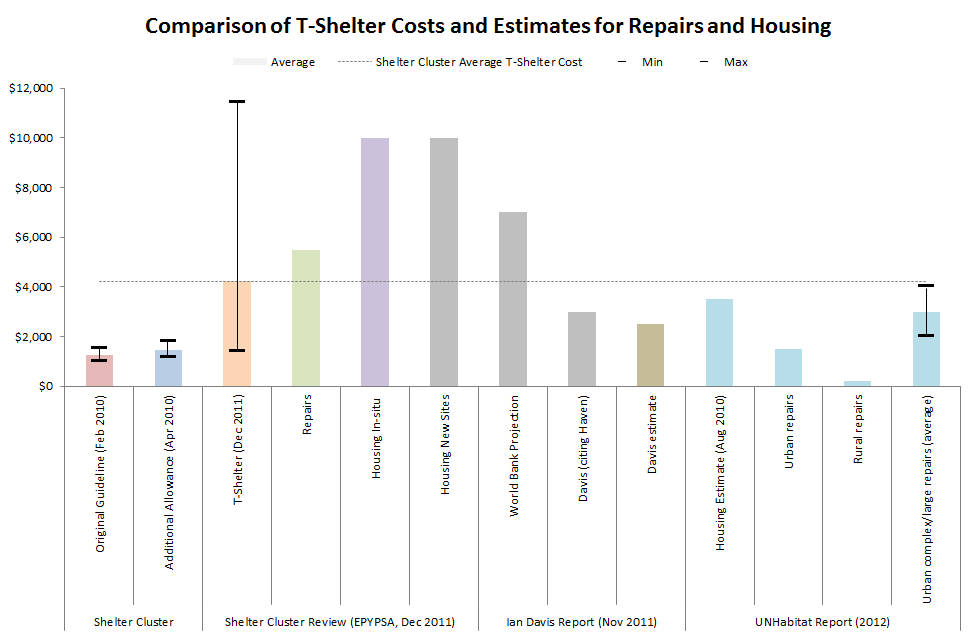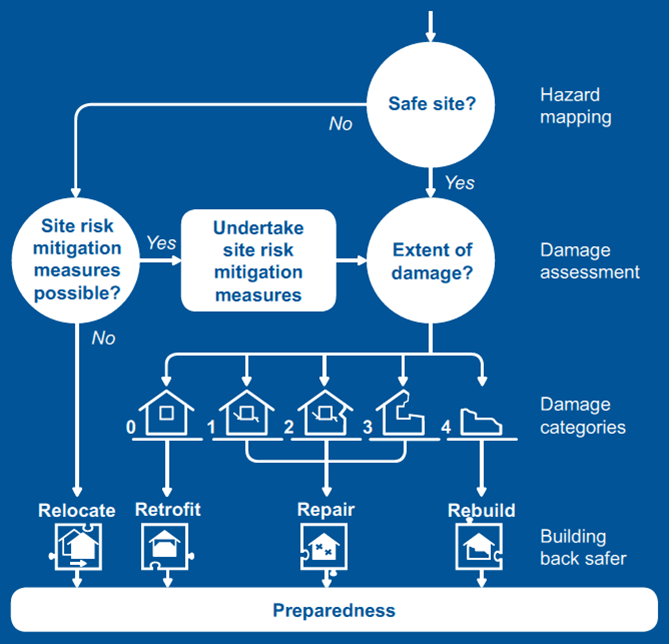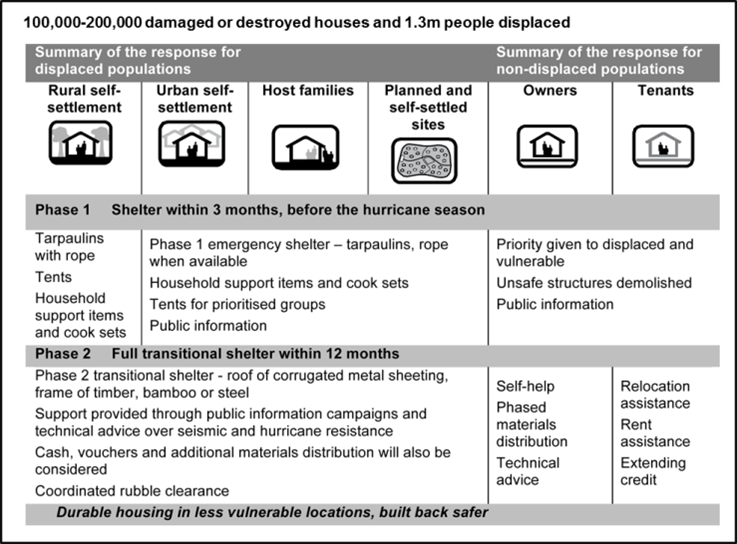Post-disaster repairs I: the case of damaged housing after earthquakes
You will always find me in the kitchen at parties talking about post-disaster repair. For three years, finding ways to make aid money flow to the repair of informal housing has been my favourite wicked problem. This series of posts is about what I learnt turning this gnawing obsession into a HIF proposal with Habitat for Humanity called Unlocking post-disaster housing pathways: rapid repair and strengthening of damaged housing during humanitarian response.
Repairs do get overlooked in humanitarian response (although HFH do lots!). After the Indian Ocean Tsunami in 2004: “hundreds of pre-tsunami houses that were culturally and climatically appropriate and easily repairable were demolished”. In Haiti, 175,000 houses were estimated to need repair, retrofit or reconstruction but even in the earliest building safety assessment only 20% of buildings were tagged red (unsafe to enter or occupy because of damage) and later analysis showed that only 8% were completely destroyed. In spite of this, UN-Habitat reported that “donors and implementing agencies focused on emergency shelter with less emphasis on repairs” and by the end of 2010, only 2,546 (of about 12,000 planned) houses had been repaired with aid money, compared to 20,000 transitional shelter kits (of 125,000 planned), not including the repairs by families who inevitably “carried out their own repairs and retrofitting”.
But why are the numbers of repairs counted by the humanitarian sector so low?
By June 2011, the Shelter Cluster reported expenditure (including project management and staffing costs as well as materials) of USD 340m for 80,000 transitional shelter kits compared to USD 28m for 5,465 repaired homes. At first glance these figures “explain” why repairs get over-looked: they are vastly more expensive per household than transitional shelter kits and apparently slower to deliver (even when transitional shelter kits turned out to be slower, more complicated and more expensive than was originally forecast). In fact, estimates for the material cost of repairing houses varied (see the graph below) but were potentially as little as 30% of the USD 5,000 average reported to the Shelter Cluster. In terms of pace, we have so little data on how fast people undertook repairs for themselves, it is impossible to conclude whether repairs are “slow”. Pace is a function of how long it takes to decide, how long it takes to get the money and labour together and how long it takes to do the work. And, of course, for an organisation working at scale unit costs and pace are intertwined: the longer it takes for an international humanitarian organisation to decide and get started, the higher the project management costs per household that has been helped.
What else is going on?
What I am exploring is whether the international humanitarian sector was caught in one of those risk-averse ‘splintering’ traps that I mentioned in my last post: humanitarian principles and standard operating procedures were inadvertently conspiring to stymie each other… For example, depending on your definition of vulnerability, a disproportionate number of vulnerable people may have lived on land that looked like an excellent, low risk livelihood opportunity because it was cheap, steep, unstable, not scrutinised by the authorities or otherwise bypassed[1]. Similarly, the sheer devastation of the earthquake is inexorably linked to the institutional vulnerabilities that themselves contributed to the proliferation of “urban-style” houses built using locally available materials (like cement blocks and concrete) but without the detailed workmanship that might prevent these brittle materials from failing without warning in an earthquake. Given this, how can an organisation simultaneously:
- Do no harm: should people be supported to repair if they live in a dangerous place or occupy land illegally?
- Provide equitable help on the basis of need: should repairs be funded if the resources are used to repair houses owned by the privileged even if these are the homes of the most vulnerable i.e. tenants?
- Build back better: should houses be repaired – returning a structure to its original condition – or should structures also be strengthened?
- Minimise programme risks: should projects that require highly skilled engineering staff (apparently in short supply) be attempted if costs, quality and pace are to be managed in an accountable manner?
It is notoriously difficult for bureaucracies to “reach” people that have dropped off (or have never been on) the radar but whether you hesitantly negotiate or resolutely skip these dilemmas, repair programmes are unlikely to get off the ground; repairs will inevitably and (slowly) take place without technical or financial support or approvals[2],[3] or any popular expectation that such things will arrive; the absence of standards and compliance will mean that financial support from donors is slow or small; the very support that might have leveraged further investment and increased quality and speed of repairs for vulnerable people in vulnerable places will not materialise. And the process of bypass continues and is amplified.
So, what if it’s not about their context but our principled control-freakery?
Though we are constantly bombarded by the idea that problems come from the particular dysfunctions or underlying faults of the context, the repair question should force us to at least contemplate the possibility that making aid money flow to alternatives is not actually about the specific, anthropological details of the context but rather the quirky anthropology of humanitarian bureaucracy.
What if we have a culture of decision-making and not a nice rational process?
One myth, intriguingly debunked by the repair question, is that all we need for good decisions to be made and good things to happen is the alignment of evidence, guidelines (codified lessons from past interventions) and strategic plans. Not only was there evidence in Haiti that hundreds of thousands of vulnerable people were left with damaged homes but shelter guidelines already included repair as an option (see the image below from this guideline) and the shelter response plan back in January 2010 allowed for support in the form of technical assistance, materials and money (see the Haiti Shelter Response Plan framework below).
What if it’s not that the dilemmas are intractable but that the premise is wrong?
It is easy to show that the dilemmas are tough. It is also possible to question whether it is legitimate for the international humanitarian sector to decide (on behalf of others) what might be harmful, better, equitable or manageable. But maybe the delusional bit of the story is that it is actually possible for any bureaucracy to simultaneously optimise, account for and control these things. In any context. Ever.
What if we’d just divvied up that $370m spent on delivering shelter kits and doing repairs for people and given 400,000 households a thousand dollars to do their own thing?
Obviously it is difficult to know whether the best option would have been to drop the money from a plane and let people get on with it. But in a way it doesn’t matter because the norms and narratives already dictate what frames “best” and this makes it impossible for this option to even be an option, let alone the best one.
Next time, we’ll look for similar challenges in other sectors. Then in subsequent posts we’ll philosophise a bit more and report the results of a survey of some of the stakeholders that have to decide whether to support people to repair their homes after disasters.
[1]Tsunami Evaluation Coalition, “Synthesis Report: Expanded Summary Joint Evaluation of the International Response to the Indian Ocean Tsunami,” 17.
[2] As evidenced by the Self-Recovery Survey by UN-Habitat and CARE in Haiti 2011 and the Self-Recovery Survey in Padang Indonesia
[3]Panosetti, “Assessment of Outstanding Shelter Need in the City of Padang: Findings and Recommendations 2009-2010 West Sumatra Earthquake Response.”












Thansk Kate for exactly describing the challenge that I am working with (again) this week. Funding secured, now the challenge of what is technically accepted.